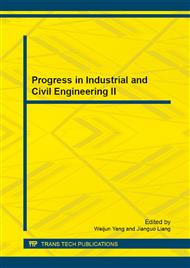p.275
p.285
p.290
p.294
p.299
p.304
p.310
p.316
p.322
Analysis on Stability of the Expensive Soil Cutting Slope Based on ANSYS
Abstract:
Landslide of expansive soil slope is a serious disease and difficult to correct in highway construction. And the mechanism of landslide of expensive soil cutting slope is complex, so the traditional slope analysis method is unable to analyze it to obtain the reasonable explanation. But the numeric analytic method can obtain the stress, strain and plastic zone of side slope analysis the distortion process of earth slope and the latent sliding plane reasonably, adopt the safety factors to evaluate the slope stability, The paper based on ANSYS and adopts the nonlinear and elastoplasticity model of soil, and use the theory of the shear strength reduction method with FEM to analysis the rule of NanYou road expansive soil landslide. Keywords:Expensive soil landslide of cutting slope swelling force FEM
Info:
Periodical:
Pages:
299-303
Citation:
Online since:
September 2013
Authors:
Price:
Сopyright:
© 2013 Trans Tech Publications Ltd. All Rights Reserved
Share:
Citation:


